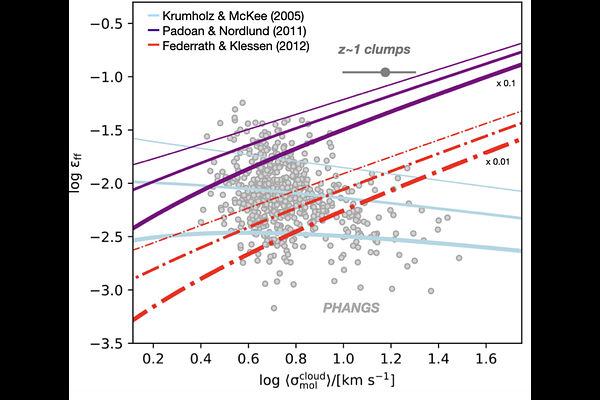Reconciling extragalactic star formation efficiencies with theory: insights from PHANGS

Reconciling extragalactic star formation efficiencies with theory: insights from PHANGS
Sharon E. Meidt, Simon C. O. Glover, Ralf S. Klessen, Adam K. Leroy, Jiayi Sun, Oscar Agertz, Eric Emsellem, Jonathan D. Henshaw, Lukas Neumann, Erik Rosolowsky, Eva Schinnerer, Dyas Utomo, Arjen van der Wel, Frank Bigiel, Dario Colombo, Damian R. Gleis, Kathryn Grasha, Jindra Gensior, Oleg Y. Gnedin, Annie Hughes, Eric J. Murphy, Miguel Querejeta, Rowan J. Smith, Thomas G. Williams, Antonio Usero
AbstractNew extragalactic measurements of the cloud population-averaged star formation (SF) efficiency per freefall time $\rm\epsilon_{\rm ff}$ from PHANGS show little sign of theoretically predicted dependencies on cloud-scale virial level or velocity dispersion. We explore ways to bring theory into consistency with observations, highlighting systematic variations in internal density structure that must happen together with an increase in virial level typical towards galaxy centers. To introduce these variations into conventional turbulence-regulated SF models we adopt three adjustments motivated by the host galaxy's influence on the cloud-scale: we incorporate self-gravity and a gas density distribution that contains a broad power-law (PL) component and resembles the structure observed in local resolved clouds, we let the internal gas kinematics include motion in the background potential and let this regulate the onset of self-gravitation, and we assume that the gas density distribution is in a steady-state for only a fraction of a freefall time. The combined result is a strong reduction to $\rm\epsilon_{\rm ff}$ predicted in multi-freefall (MFF) scenarios compared to purely lognormal probability density functions and variations that are tied to the PL slope $\alpha$. The $\alpha$ needed to match PHANGS $\rm\epsilon_{\rm ff}$'s vary systematically with environment in the sense that gas sitting furthest from virial balance contains more gas at high density. With this `galaxy regulation' behavior included, our `self-gravitating' sgMFF models function similar to the original, roughly `virialized cloud' single-freefall models. However, outside disks with their characteristic regulation, the flexible MFF models may be better suited.